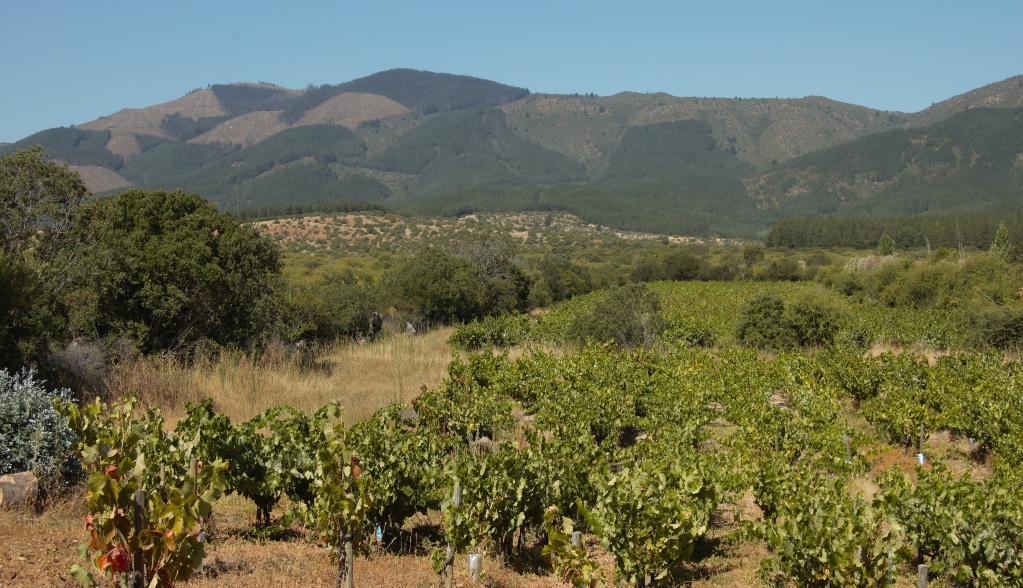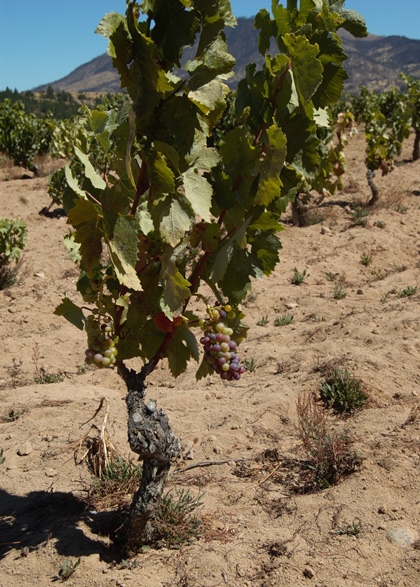Carignan has not garnered many friends around the world. Indeed, the opinion of many leading wine experts could well make you decide to steer clear of the variety. Check out this quote, for instance, on the Carignan profile from the bible of the wine world, the Oxford Companion to Wine:
“In much of southern France its wine is high in everything—acidity, tannins, colour, bitterness—but finesse and charm. This gives it the double inconvenience of being unsuitable for early consumption yet unworthy of maturation. “
It’s clearly not the easiest of varieties to work with, needing a warm climate to ripen and being susceptible to rot and both types of mildew – especially powdery mildew. Its tough stems makes machine harvesting tricky. It tends to be very vigorous and high-yielding and when yields are high, the tannins don’t ripen, making them harsh, green and bitter, hence all the allegations of astringency in the wines. And it is thanks to producers, especially in southern France, looking to produce high yields of Carignan to blend with other varieties like Syrah, Mourvèdre and Cinsault, that Carignan has come to have such a bad name.
However, there is another side to the story. There are a a few enclaves around the world where you can find staunch supporters of this variety. For instance, Carignan is an important component in blends in Priorat, Spain, where the variety is called Cariñena or Samsó. And in Sardinia, old-vine, bush-trained Carignane, as it is known, is being made into some very fine wines. Maule in Chile is following suit and we headed down south to find out what is going on there with this much-maligned variety.

Bush-trained, dry-farmed old Carignan vines at Miguel Torres’ Huerta de Maule vineyard
Miguel Torres makes wines from Carignan grapes in both Priorat and Maule, so our first stop was to talk to Fernando Almeda of Miguel Torres, who explained the secret to obtaining good wines from Carignan:
“With water availability Carignan grows a lot and the bunches become bigger and bigger, so the wines finish diluted with green tannins and don’t achieve phenolic maturation. (…) The soils have to be quite poor, with low organic material, for this same reason. Because when you have high organic material, the bunches are very big and the wine is very diluted, and it doesn’t get phenolic maturation. They key is to arrive, with this strong variety, to phenolic maturation. With low organic material and low water availability, it is possible to get there.”
And poor soils and zero irrigation or rainfall during the growing season are factors that both Priorat and Maule share. Both also have a continental climate with significant differences in temperature between daytime and nighttime, making for slower, steadier ripening. However, they do have some differences. While their soils are poor, they are different in composition: in Priorat, they are darker-coloured, based on metamorphic, schist material, while in Maule they are lighter-coloured and granitic. Fernando explained that the resulting wines have a few differences too, with Priorat Carignan being lighter in colour, slightly lower in acidity and with rounder tannins and a more fruity profile compared to the herbal, spicy character of Maule Carignan. However, at the end of the day, they both tend to have grippy tannins and high acidity.

Bush-trained vine
The age of the vines and the form of training are also clearly important factors. When vines are more than twenty years old, their yields naturally decline, making for more concentrated grapes. Most Carignan vines in Chile are, in fact, well over 20 years’ old, many having been planted in the 1940s and 50s.
These vines, long disregarded by the big wineries, have been tended by viticulturists using traditional methods, who have trained them into a free-standing bush or gobelet shape, which naturally limits yields and helps vines cope with sun exposure and the lack of water.

This vine is likely to produce less than half a kilo of grapes
Sebastián Bustamente, vineyard manager at Odfjell Vineyards, explained that increasing attention is now being placed on thinning out clusters and keeping vines well pruned so as to ensure a lower yield of fully ripe grapes. Yields in Maule can be as low as a kilo (or even less) per vine.
The vineyards in Maule are certainly labour-intensive, with skilled workers needed to manage processes like pruning, training, cluster-thinning and harvesting.
What’s more, the ground at many vineyards is worked by horses, who plough up the weeds and grass in spring. All-in-all, such low yields and labour-intensive work must certainly add significantly to the costs of making this wine, so is it all worth it?
Andrés Sánchez, the Chairman of the Vigno association of Carignan producers, certainly thinks so:
“I think Carignan is the variety that shows the potential of what Chile can produce, much more than Carmenère or other varieties. And this is a variety with history, with heritage behind it.”
He added that all the producers of Chilean old-vine Carignan have had to learn from scratch how to make good wines from these grapes, and there’s a clear evolution in the wine styles as Amanda discusses in her feature (coming soon!) In general Maule Carignan is very concentrated in colour and aroma with has red, and sometimes black, fruit notes as well as floral, earthy and meaty aromas. It can have spicy, sometimes rustic, tannins and always has a fresh acidity.
While winemaking techniques vary, at the end of the day, what seems to matter most in Carignan wine is terroir and viticulture. De Martino Winemaker Eduardo Jordán emphasized this point:
“Our philosophy is to do good work in the vineyard and then the winemaker’s job is not to mess it up. Harvesting at the right time is crucial and it’s better to harvest a bit early than a bit late. That means healthy grapes that are fresh and have vibrant fruit expression.”
Amen to that.

The gnarled trunk of this vine tells the story of decades of long, hot, dry summers

